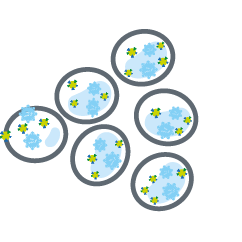Adding the MF59® Adjuvant to the influenza vaccine significantly enhances antibody responses*1,2.
Antigen + MF59® Adjuvant
Increases the magnitude of the antibody response by stimulating more immune cells to create more antibodies.*3,4
Broadens the antibody response by creating higher levels of cross-reactive antibodies.*3-5
Impact of MF59® Adjuvant
Magnitude
FLUAD elicited significantly higher antibody responses against homologous A/H1N1, A/H3N2 and B strains (p<0.001).*3
Breadth
FLUAD elicited significantly higher antibody responses against selected heterologous A/H3N2 strains.*3-5
Persistence
FLUAD elicited significantly longer antibody responses against the homologous A/H3N2 strain*†3
† Secondary endpoint. Primary endpoint was not met.
Haemagglutination inhibition (HI) antibody titres are used as a surrogate marker for protection against influenza.1
This may be important when circulating strains have drifted from vaccine strains.5
The duration of immunity varies for influenza vaccines, but it is usually 6–12 months.1,3
*compared to non-adjuvanted, standard dose influenza vaccines
Reference: 1. Seqirus NZ. FLUAD Quad Data Sheet. Seqirus (NZ) Ltd. November 2022. 2. Podda A. The adjuvanted influenza vaccines with novel adjuvants: experience with the MF59®-adjuvanted vaccine. Vaccine. 2001;19(17-19):2673-2680. 3. Frey SE, Reyes MR, Reynales H, et al. Comparison of the safety and immunogenicity of an MF59®-adjuvanted with a non-adjuvanted seasonal influenza vaccine in elderly subjects. Vaccine. 2014;32(39):5027-5034. 4. Ansaldi F, Zancolli M, Durando P, et al. Antibody response against heterogeneous circulating influenza virus strains elicited by MF59®- and non-adjuvanted vaccines during seasons with good or partial matching between vaccine strain and clinical isolates. Vaccine. 2010;28(25):4123-4129. 5. O’Hagan DT, Rappuoli R, De Gregorio E, et al. MF59® adjuvant: the best insurance against infl uenza strain diversity. Expert Rev Vacc 2011; 10(4):447–462.






